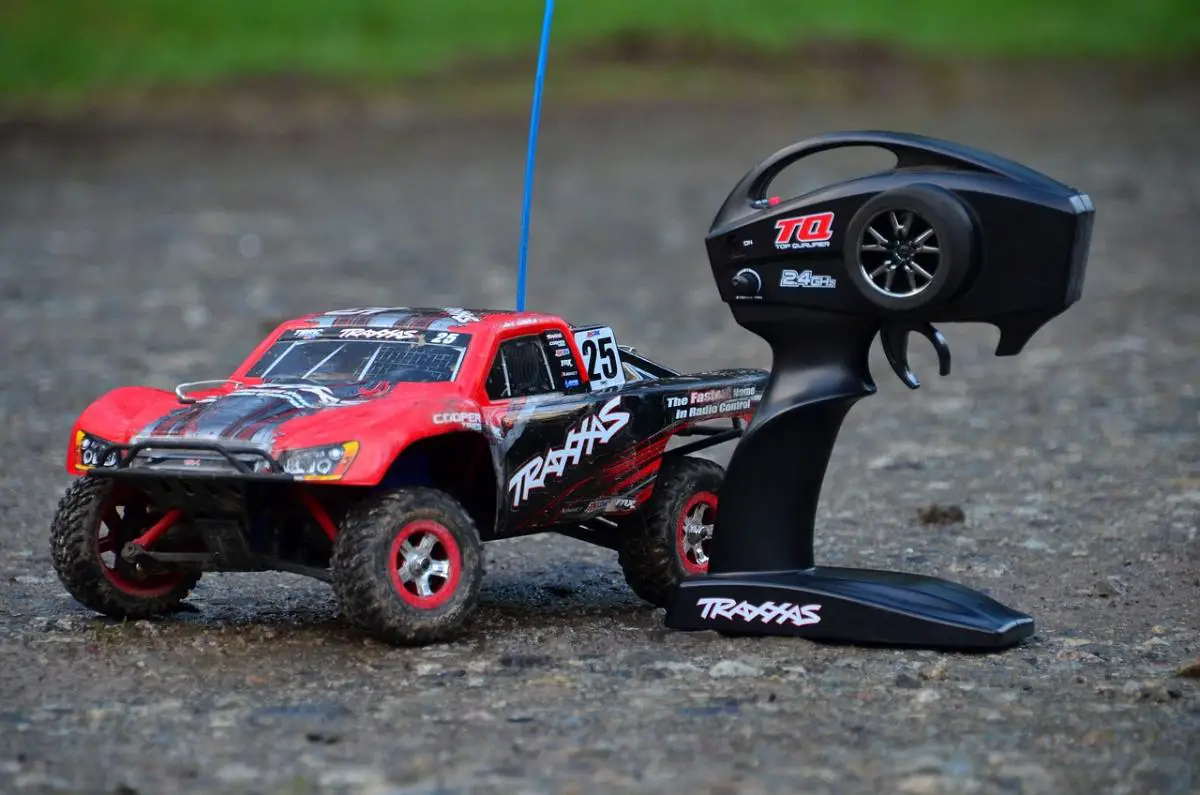If you are curious about the importance of line of sight for your RC car and transmitter, and the kind of range your RC car needs keep reading. Also, learn the frequency these cars typically run on.
Do RC Cars Need Line Of Sight?
No. Traditional RC cars, which operate on certain radio frequencies such as 27MHz or 49MHz, typically don’t require a direct line of sight. These frequencies can penetrate walls and obstacles to some extent. However, there are limitations:
- Range: The range can be limited, usually within a few hundred feet. Obstacles can further reduce this range.
- Interference: Other electronic devices, physical barriers, or even other RC cars on the same frequency can cause interference, leading to loss of control.
Modern RC Cars with 2.4 GHz Systems
Many modern RC cars utilize 2.4 GHz frequency systems, providing better range and less interference. Although they still don’t require a direct line of sight, the following factors should be considered:
- Improved Range: The range is significantly better, often exceeding a thousand feet.
- Avoiding Obstacles: While the line of sight isn’t necessary, the user must still consider physical barriers that could affect control and visibility.
FPV (First Person View) Systems
Some advanced RC cars are equipped with FPV systems, allowing drivers to control the car through a video feed. Here, line of sight becomes a more complex issue:
- Signal Transmission: FPV systems often rely on frequencies that require a stronger line of sight. Obstructions can cause the video feed to be lost or become glitchy.
- Legal Considerations: Depending on the jurisdiction, there may be legal requirements concerning the line of sight while operating an FPV RC car.
What Is Line Of Sight?
Line of sight refers to a direct, unobstructed path between two points. In the context of RC cars, it is the clear, unblocked pathway between the transmitter (usually a handheld remote) and the receiver within the car.
How Far Away Can You Control an RC Car?

Here are the typical ranges based on the type of RC car you have:
Entry-Level RC Cars
Entry-level or toy-grade RC cars usually have a control range between 30 to 100 feet. They are designed for indoor or close-proximity outdoor use and often operate on lower frequency bands.
Hobbyist RC Cars
For hobby-grade RC cars, the control range may extend up to 1000 feet, especially if using a 2.4 GHz frequency band. The more advanced technology used in these cars facilitates better signal strength and range.
Professional RC Cars
Professional RC cars used in racing or other specialized applications may have a range exceeding a mile, particularly when customized with high-end transmitters and receivers.
Understanding the Basics
Here are some fundamentals of frequency, signal strength, transmitter power, and line of sight.
Frequency and Signal Strength
RC cars usually operate on certain frequency bands such as 27 MHz, 49 MHz, or 2.4 GHz. The higher the frequency, the less likely it is to be affected by interference, and often, the greater the range of control.
Transmitter Power
The power of the transmitter determines how strong the signal is. A stronger signal means a longer control range. The transmitter’s power is measured in milliwatts (mW), and a higher value typically equates to a greater range.
Line of Sight
Having a clear line of sight between the transmitter and the RC car usually ensures the most reliable control. Obstacles like walls, trees, or other electronic devices can interfere with the signal and reduce the effective range.
Tips to Enhance Control Range
- Upgrade Your Transmitter: Investing in a more powerful transmitter can significantly improve your RC car’s range.
- Maintain Line of Sight: Avoid obstacles between the transmitter and the car to ensure a strong and consistent signal.
- Avoid Interference: Stay away from other electronic devices or objects that might cause signal interference.
- Keep Equipment in Good Condition: Regularly inspect and maintain your RC car’s transmitter and receiver for optimal performance.
Safety Considerations
Always be aware of your surroundings when using an RC car, especially when pushing the limits of its control range. Losing control of the vehicle can lead to accidents or damage.
What Frequency Do RC Car Transmitters Use?
RC cars typically operate on two main frequencies: 27 MHz and 2.4 GHz.
27 MHz Frequency Band
The 27 MHz band is among the older and more traditional frequencies used in RC cars. There are usually six channels available within this band, allowing for a reasonable number of different devices to operate simultaneously without interference.
Advantages:
- Lower cost
- Simplicity of design
- Compatibility with older models
Disadvantages:
- Limited channels
- Greater susceptibility to interference from other electronic devices
- Reduced range
2.4 GHz Frequency Band
With advancements in technology, the 2.4 GHz band has become the standard for most modern RC cars.
Advantages:
- Increased range
- More channels, which minimizes interference between multiple cars
- Automatic channel selection, allowing for a smoother connection
Disadvantages:
- Typically more expensive
- Some compatibility issues with older models
Other Frequencies
In addition to the primary bands, some countries or specialized systems may use different frequencies, such as 40 MHz or 72 MHz. It is essential to ensure that your RC car’s transmitter and receiver are compliant with your country’s regulations.
Why Does Frequency Matter?
- Interference: Multiple cars operating on the same frequency may interfere with each other. A unique frequency or channel ensures smooth operation.
- Range: Different frequencies offer various ranges, which can be essential depending on your use.
- Compatibility: Matching frequencies between the transmitter and receiver is crucial for the proper functioning of your RC car.
